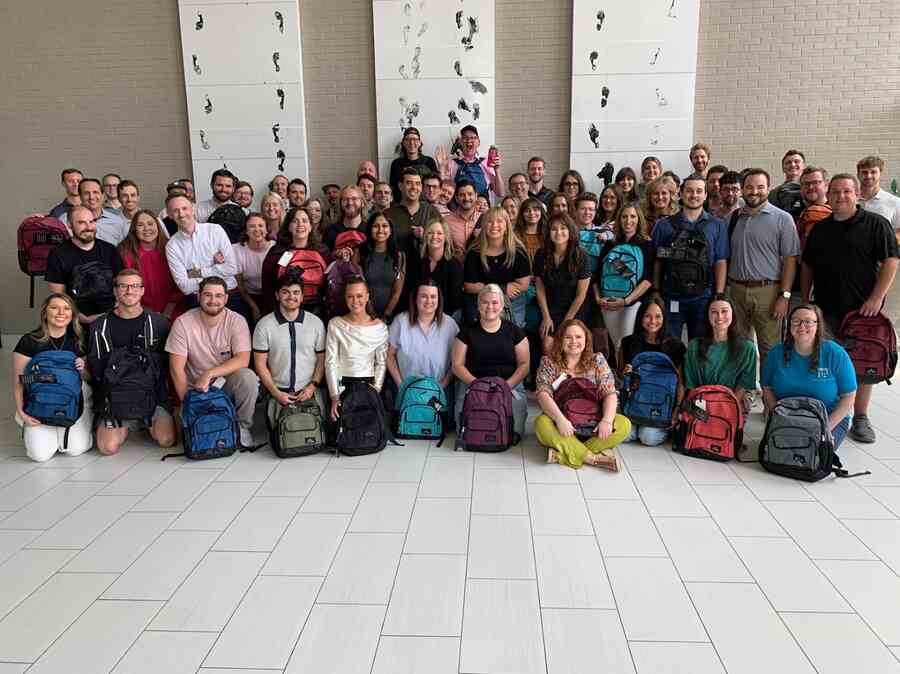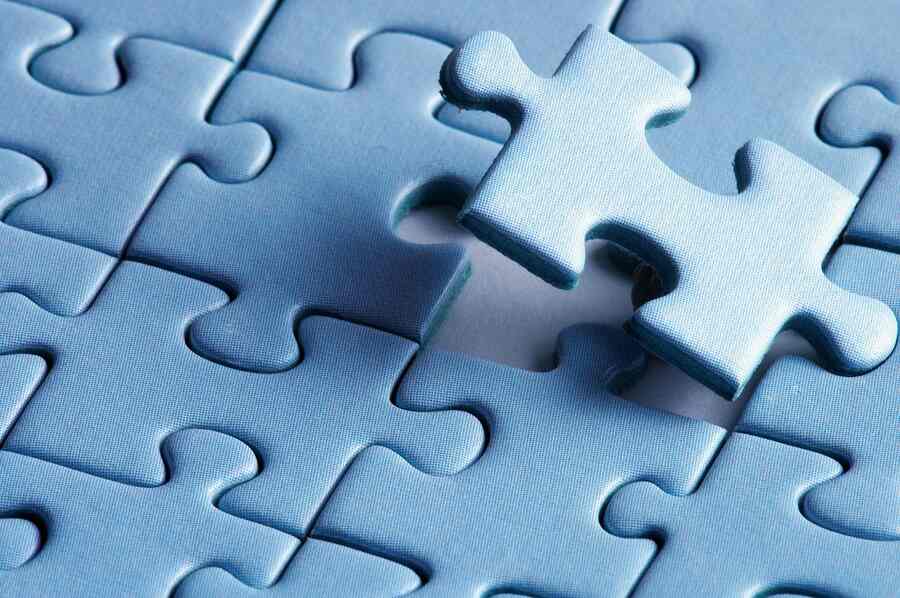Team-building activities for work are exercises that encourage a group to work together toward a common goal. It can be a valuable tool for you, no matter the size of your company, to use in improving employee and team performance and morale. Team building helps team members get to know each other better, work together effectively, and develop trust and respect for each other.
We’ve broken down our team-building exercises for work into categories—physical, collaboration and teamwork, problem-solving and critical thinking, trust and communication, and social skills—to help you build your own team-building initiatives.
Physical Team-building Activities
Physical team-building exercises for work are best for larger groups (ideally at least 20 people) and help improve collaboration, communication, teamwork, and camaraderie by participating in a physical activity.
1. Outdoor Adventure Courses
- Purpose of Activity: Build trust, communication, problem-solving, and resilience
- Group Size: 20-plus
- Time Commitment: 1 hour-plus
- Difficulty: High
- Cost: Moderate (Approx. $70 per person)
Adventure courses, such as ropes courses or zip-lining, challenge teams to navigate physical obstacles together. The number of people for the outdoor adventure depends on the type of course. When planning this, also consider the skill level of participants, the difficulty of the course, and the location. It is important to have insurance for the event in case of accidents or injuries.
Outdoor adventure activity costs can range significantly based on the type and duration of the adventure, the location, and the number of employees. A team-building adventure from Adventureworks in Nashville, TN, for example, costs about $70 per person—although there is a group discount. Other providers will offer an activity as part of a package that includes transportation, food, etc. To save on cost, you could consider hosting your own activity.
2. Scavenger Hunts
- Purpose of Activity: Teamwork, strategic thinking, collaboration, creativity, communication, time management
- Group Size: 20-plus
- Time Commitment: 1hour-plus
- Difficulty: Easy to moderate
- Cost: Low to moderate (Approx. $10 to $100-plus per person)
A scavenger hunt is a game in which players search for hidden items or objects based on a set of clues. Scavenger hunts can be played indoors or outdoors and customized to fit any occasion. You can also have a themed scavenger hunt. For example:
- Historical scavenger hunt: The activity involves finding historic landmarks, markers, or statues in a specific location.
- Food scavenger hunt: Here, participants must look for the ingredients of a recipe or dishes in different restaurants.
- Nature scavenger hunt: This could involve finding specific animals, plants, or other natural features in a park or any outdoor location.
While you might think that a scavenger hunt is a great opportunity for your employees to find work-related items, I caution against this. The purpose of the activity is to build trust and teamwork among your employees. Taking them out of the office and focusing on fun instead of work will increase their overall satisfaction with your company culture.
The total budget for a scavenger hunt depends on whether you host it yourself or hire a planner. With a planner, pricing can range from a few hundred dollars to several thousand dollars, depending on the size of the event, the location, and the complexity of the scavenger hunt. For example, Let’s Roam hosts scavenger hunts in cities across the US, with individual tickets starting at about $13. Its corporate-focused events, however, require a custom quote.
3. Sports Tournaments
- Purpose of Activity: Teamwork, reliability, delegation, cooperation, friendly competition
- Group Size: 20-plus
- Time Commitment: 1 hour-plus
- Difficulty: Moderate to hard
- Cost: Moderate to high (Approx. $30 to $50 per person or $875 to $1,500-plus per organization)
Organizing sports tournaments, such as soccer, softball, basketball, or volleyball, provides a competitive yet enjoyable team-building opportunity. It allows employees to bond over shared goals and experiences. But, don’t forget those that cannot participate for various reasons—they can be scorekeepers or coaches instead.
The budget for sports tournaments as a fun team-building activity can vary depending on a number of factors, including the size of the team, the type of sport, and the location of the tournament. For example, a team-building sports event hosted by KC Crew in Kansas City, Missouri will cost around $30-$50 per person for a half-day event.
If you want to host the event yourself, a general budget might look something like this:
- Venue rental: $500-$1,000
- Equipment rental: $200-$500
- Food and drinks: $50-$100 per person
- Transportation: $25-$50 per person
- Swag: $50-$100
- Miscellaneous: $50-$100
Collaboration and Teamwork Activities
These activities promote collaboration and teamwork by grouping individuals together to compete against another group. They must work together to complete the task.
4. Office Trivia or Game Night
- Purpose of Activity: Teamwork, communication, strategic thinking
- Group Size: 5-plus
- Time Commitment: 30 minutes-plus
- Difficulty: Easy to moderate
- Cost: Low to moderate (Approx. $10 to $100)
Organizing an office trivia or game night promotes friendly competition and teamwork. Teams can participate in trivia quizzes, board games, or even virtual team-building games.
The potential cost for this activity is minimal, generally just including the games or materials needed to make your own games. As with several of our other suggested activities, you might consider awarding the winner a gift card or company swag.
Alternatively, if you choose to take your employees to a restaurant that supports/hosts a trivia night, costs would include transportation, food and beverages, and potentially a game board fee. If your whole team is remote, you can host a virtual trivia night. Escapely offers one-hour games with a guided leader.
5. Community Service Projects
- Purpose of Activity: Empathy, leadership, collaboration, positive company culture
- Group Size: 15-plus
- Time Commitment: 1 hour-plus
- Difficulty: Easy
- Cost: Low to moderate (Approx. $0 to $100-plus)
Engaging in community service projects as a team provides an opportunity to give back while fostering teamwork and empathy. Activities such as volunteering at a local shelter, organizing a neighborhood clean-up, or participating in charity events build a sense of purpose among employees.
If many of your team members work a remote or hybrid schedule, take advantage of the times they are in the office. Our company, for example, plans community service projects to correspond with our quarterly company meetings—when more people are naturally in the office.
Some potential costs associated with community service projects may include transportation, food and drinks, and volunteer supplies. Also, note that some organizations may charge a participation fee for volunteers.

TechnologyAdvice participates every year in Nashville, TN’s Backpack Buddies, giving back to the community while building team camaraderie. (Source: TechnologyAdvice)
6. Collaborative Art Projects
- Purpose of Activity: Creativity, communication, collaboration, teamwork, patience, respect
- Group Size: 4-plus
- Time Commitment: 30 minutes-plus
- Difficulty: Easy to moderate
- Cost: Low (Approx. $30 per person)
Engaging in collaborative art projects, such as painting or sculpting, allows employees to express their creativity while fostering teamwork and communication. This activity encourages individuals to combine their unique skills and ideas to create a collective piece of art, symbolizing collaboration and unity.
A sample budget for a collaborative art project for 10 people is around $30 per person for materials.
7. Corporate Castaway
- Purpose of Activity: Trust, communication, problem-solving, leadership, creativity
- Group Size: 20-plus
- Time Commitment: 1 hour-plus
- Difficulty: Moderate to hard
- Cost: Moderate to high (Approx. $6,000 to $7,000-plus per organization)
This activity is designed for at least 20 people and can be done indoors or outdoors. It simulates the experience of being stranded on a desert island, and it requires teams to work together to survive. The teams will have a set amount of time to complete each challenge. The first team to complete all of the challenges wins.
Costs are moderate to high, depending on the size of the group, the location, and the activities that are chosen. However, some of the most common budget items include venue rental, challenge equipment, food and drinks, transportation, and staffing. Outback Team Building offers a Corporate Castaways activity package that is custom-quoted, although the group minimum is around $7,000.
Problem-solving and Critical Thinking Activities
These activities require critical thinking skills and problem-solving to complete challenges. They build camaraderie and enhance communication between team members to solve problems and complete missions.
8. Escape Rooms
- Purpose of Activity: Problem-solving, communication, teamwork, time management
- Group Size: 4-plus
- Time Commitment: 1 hour-plus
- Difficulty: Moderate to hard
- Cost: Moderate to high (Approx. $30 to $70 per person)
Escape rooms offer an exciting challenge that requires teams to work together to solve puzzles and escape within a specified time limit in a fun and immersive environment. This activity is a great way to let employees see how well others work under pressure. In a past job, I participated in an escape room. It was fun, challenging, and helped me to build new relationships with coworkers.
However, an escape room can also cause panic, as employees are locked in a room and must race against the clock to find the way out by solving puzzles and looking for clues. For employees that may be claustrophobic or have heart issues, it may not be an appropriate activity.
The cost for this activity depends on the escape room you choose and also if you will provide snacks to the participants. A rough estimate will be between $30 and $70 per person. The Great Escape in Austin, TX, for example, has team-building escape room experiences starting at about $40 per person.
9. Team-building Workshops
- Purpose of Activity: Collaboration, teamwork, productivity
- Group Size: 10-plus
- Time Commitment: 1 hour-plus
- Difficulty: Easy
- Cost: Low to moderate (Approx. $15 to $20-plus per person)
Facilitating team-building workshops that focus on specific skills, such as communication, problem-solving, or conflict resolution, can be highly effective. This is also an excellent activity for an in-person collaboration event, especially if your team is remote and you gather in person annually.
Some of the budget considerations for this activity include the location, the type of workshop, and the materials needed. You should also factor in the food and drinks in the equation. A sample budget for a group of 10 people will be around $180 to $200.
10. Marshmallow Challenge
- Purpose of Activity: Innovation, teamwork, creativity, resourcefulness, planning, organization
- Group Size: 4-plus
- Time Commitment: 15 minutes-plus
- Difficulty: Easy
- Cost: Low (Approx. $1 to $2 per team)
This game involves 20 spaghetti sticks, one yard of tape, and one marshmallow. The goal is to build the tallest freestanding structure using only these materials within a specified time limit (e.g., 20 minutes). Teams must strategize, collaborate, and experiment with different designs to create a stable tower.
These basic supplies cost $1 to $2 per team.
11. Team Drawing
- Purpose of Activity: Creativity, adaptability, communication, collaboration
- Group Size: 4-plus
- Time Commitment: 30 minutes-plus
- Difficulty: Easy
- Cost: Low (Approx. $5 to $20 per person)
Divide the group into small teams and provide each team with drawing materials (paper, markers, crayons, etc.). Instruct each team to create a collaborative drawing, but with a twist: only one person can draw at a time, and team members must take turns without verbal communication. Team members must find alternative ways to understand each other’s intentions and contribute to the final drawing.
To keep it fun, assign the art project to the first person on the team. They are the only ones that know what the art is supposed to look like. Then the first person, without talking, must draw as much as they can in their time allotted (e.g., 30 seconds) and then let the next person on the team complete the drawing, and so on.
The cost for the Team Drawing activity depends on the materials you choose to use. For example, if you use paper and pencils, the cost will be minimal. If you use more specialized materials, such as markers or paints, the cost will be higher. As a general guideline, it could cost around $5 to $20 per person.
12. Picture Puzzle
- Purpose of Activity: Teamwork, communication, problem-solving skills, negotiation
- Group Size: 16-plus
- Time Commitment: 30 minutes-plus
- Difficulty: Easy to moderate
- Cost: Low (Approx. $10 to $20)
This activity involves dividing the team into smaller groups and giving each group a puzzle to solve. The puzzles are made up of individual pieces that must be put together to form a complete picture. To play the game, divide the team into smaller groups of 4-6 people and give each group a puzzle to form together. The teams must discuss the puzzles, share ideas, and help each other out.
If you are creating your own puzzles, you will need to purchase paper, markers, and scissors. This can cost anywhere from $10 to $20.

Puzzles require cognitive thinking skills and can be a great team building exercise. (Source: Adobe Stock)
13. Human Knot Relay
- Purpose of Activity: Teamwork, problem-solving skills, communication, creativity
- Group Size: 20-plus
- Time Commitment: 30 minutes-plus
- Difficulty: Easy to moderate
- Cost: Low (Approx. $0 to $20)
Create several circles of participants, with each circle consisting of about 10 people standing shoulder-to-shoulder, facing inward. Instruct participants to reach across the circle and hold hands with someone opposite them. The challenge is for the groups to untangle themselves without letting go of each other’s hands. The final result will be a large circle with all participants holding hands with the person next to them.
Unless you decide to do the activity in another location and serve snacks for the participants, you won’t have to spend anything for this employee team-building activity. If you choose the former, you can expect to spend between $10 to $20 per person.
14. Tower of Cups
- Purpose of Activity: Focus, communication, problem-solving skills, teamwork, patience, creativity
- Group Size: 15-plus
- Time Commitment: 30 minutes-plus
- Difficulty: Easy
- Cost: Low (Approx. $5 to $25)
The activity involves stacking plastic cups in a tower, one on top of the other. The number of cups will depend on the skill level of the participants. Then, players take turns stacking cups on top of the tower. The goal is to stack the cups as high as possible without knocking them over. A player loses their turn if they knock over the tower or if they touch the tower with their hands. The player who stacks the most cups without knocking over the tower wins the game.
The cost of the Tower of Cups activity will vary depending on the number of players and the materials that you use. A set of plastic cups costs anywhere from $5 to $25, depending on the number.
15. Murder Mystery
- Purpose of Activity: Collaboration, communication, trust, problem-solving, critical thinking
- Group Size: 10-plus
- Time Commitment: 1 hour-plus
- Difficulty: Moderate
- Cost: None to moderate (Approx. $0 to $750-plus)
A “who-done-it” murder mystery activity will get the group thinking together to discover the mystery. It doesn’t have to be a murder. If you prefer, it could be something that was taken, like a priceless piece of art, where your employees will solve who did it.
This type of activity uses problem-solving skills and critical thinking to follow the clues and gather evidence to uncover the culprit. Much like the escape room, during a murder mystery activity, your employees will communicate and work together as a group, enhancing team bonding and engagement.
The cost of a murder mystery activity can be minimal, with only the cost of materials. However, it can be extremely time-consuming to create a murder mystery from scratch. There are games or cards that can be purchased online to help with planning.
If you hire a mystery planner, like A Murder Mystery Dinner, they will plan everything for you. Pricing starts at $750, which includes the game and company-hired characters who host and play a role in the mystery.
Trust and Communication Activities
Trust activities require employees to communicate and work together. They involve relying on other team members to complete tasks.
16. Trust Fall
- Purpose of Activity: Trust, communication, reliability, teamwork
- Group Size: 4-plus
- Time Commitment: Low
- Difficulty: Easy
- Cost: None
Pair up participants and have one person stand with their back to the other, ready to fall backward. The person standing behind acts as the catcher and must ensure the faller’s safety by catching them and gently lowering them to the ground.
This simple and quick activity does not require any money or additional materials.
17. Minefield
- Purpose of Activity: Teamwork, collaboration, communication, listening skills
- Group Size: 5-plus
- Time Commitment: 30 minutes-plus
- Difficulty: Easy to moderate
- Cost: None to low (Approx. $0 to $20)
This is one of the team-building exercises for work that does not cost you money because it uses objects you already have. It involves dividing the team into two groups and having each group send a blindfolded member through a minefield. The blindfolded members must rely on their teammates to guide them through the minefield without stepping on any mines. Here’s a more detailed instruction for minefield.
This activity often costs nothing, although you may need to purchase some basic materials, such as blindfolds, masking tape, and soft objects to serve as “mines.” If you are holding the event at an off-site location, you will need to factor in the cost of renting the space.
18. Human Bingo
- Purpose of Activity: Team sprint, camaraderie, social skills, listening skills
- Group Size: 25-plus
- Time Commitment: 30 minutes-plus
- Difficulty: Easy
- Cost: None to Low (Approx. $0 to $125-plus)
It is a fun and interactive game that can be played with a group of people. The game is similar to traditional bingo, but instead of using numbers, players collect people who match the descriptions on their bingo cards. This game can also be played remotely. Here are more detailed instructions on how to play human bingo.
Bingo cards with descriptions can cost around $1 to $5 per card. If you do it online, it doesn’t cost anything. However, you will need a video conferencing platform, digital Bingo cards, and a randomizer, such as this one from Picker Wheel.
19. Charades
- Purpose of Activity: Rapport, teamwork, creativity, collaboration, communication
- Group Size: 20-plus
- Time Commitment: 30 minutes-plus
- Difficulty: Easy to moderate
- Cost: None
This is a classic game that is always a lot of fun. To play, have everyone divided into teams. Each team takes turns acting out a word or phrase without speaking. The other team has to guess what the word or phrase is. This is a great exercise for improving communication and creativity.
You don’t have to spend anything for this activity. However, you could give some gift cards or cash to the winning team.
Social Skills Team-building Activities
These activities help build social skills among your employees. It is a way for them to learn about each other.
20. One-on-One Coffee or Lunch
- Purpose of Activity: Connection, trust, communication, social skills
- Group Size: 2-plus
- Time Commitment: 30 minutes-plus
- Difficulty: Easy
- Cost: Low (Approx. $5-plus per person)
Arrange casual one-on-one coffee or lunch sessions between team members. These can be in person or through a virtual meeting. Encourage participants to share their goals, interests, and experiences, creating a supportive and collaborative environment.
The cost of coffee or lunch will vary depending on the frequency or number of team members involved.

Virtual coffee meetings are a great way for employees to build relationships from anywhere in the world. (Source: Adobe Stock)
21. Book Club
- Purpose of Activity: Critical thinking, collaboration, knowledge, public speaking
- Group Size: 4-plus
- Time Commitment: 3 months-plus
- Difficulty: Easy
- Cost: Low to moderate (Approx. $10 to $100 per person)
Choose a book that aligns with the team’s interests or professional development goals. Assign chapters or sections to each team member, and schedule regular discussions to share insights, thoughts, and key takeaways.
The budget for this depends on whether the company will buy books for each participant.
22. Knowledge and Skill-sharing Sessions
- Purpose of Activity: Knowledge, public speaking skills, planning, time management
- Group Size: 2-plus
- Time Commitment: 30 minutes-plus
- Difficulty: Easy
- Cost: None to low (Approx. $0 to $50-plus)
Encourage team members to share their individual skills or expertise with the group. Each member can lead a short session where they teach the others a particular skill or offer insights into their area of expertise. These sessions are a great opportunity for employees to hone their presentation/public speaking, time management, and other skills.
This activity is as much for the employee sharing the information as those receiving the information. I recommend keeping these sessions light and allowing employees to share anything they are passionate about, not just work-related information. TechnologyAdvice, for instance, offers “Wisdom Wednesdays” where employees can teach or share with others about a topic they are passionate about.
The basic activity generally costs nothing, although we recommend giving a gift card or spot bonus to people who volunteer to present.

Sharing skills gives employees the opportunity to learn new things. (Source: Adobe Stock)
23. Two Truths and a Lie
- Purpose of Activity: Trust, listening skills, critical thinking
- Group Size: 2-plus
- Time Commitment: Low
- Difficulty: Easy
- Cost: None
In this office team-building activity, participants take turns sharing three statements about themselves, two of which are true and one that is false. As each person presents their statements, the rest of the team listens attentively and tries to identify the lie. It encourages individuals to share personal information in a fun and nonthreatening manner, fostering a sense of trust and openness within the team.
The budget for two truths and a lie is essentially zero. The game can be played with no materials or preparation whatsoever.
24. Team Cooking Classes
- Purpose of Activity: Collaboration, communication, time management, cooperation
- Group Size: 4-plus
- Time Commitment: 1 hour-plus
- Difficulty: Moderate
- Cost: Moderate to high (Approx. $25 to $100 per person per hour)
A team cooking class is a team-building activity where a group of people come together to learn how to cook a meal. There are many different types of team cooking classes available, so you can find one that fits the interests and needs of your group, such as vegan or dessert cooking classes.
In-person cooking classes can cost between $25 and $100 per hour and depend on the type of cuisine you choose. This can be a particularly good event for remote teams. The Table Less Traveled offers virtual cooking classes for $750, with a minimum of 10 people.
25. Debate Duel
- Purpose of Activity: Communication, time management, cooperation, healthy debate
- Group Size: 2-plus
- Time Commitment: 30 minutes-plus
- Difficulty: Easy to moderate
- Cost: None
A great way to build team camaraderie and make your employees think is to host a debate duel. In these duels, two individuals (or two groups) go head-to-head to debate a topic. Your other employees will be the jury, deciding who the winner is based on knowledge, passion for the topic, and even humor.
The cost for a debate duel can be free. You can also consider awarding a trophy to the winners, resulting in minimal costs for materials.
Why Team-building Activities for Work Are Important
Team-building exercises play a significant role in human resources (HR) for several reasons. Here are some of the key benefits and significance of HR team-building exercises:
- Improved Communication: Team-building exercises often involve activities that encourage open communication among team members. Improved communication leads to better understanding, fewer misunderstandings, and increased efficiency in the workplace. Learn more about employee management in our guide.
- Enhanced Collaboration: These exercises promote teamwork and foster a sense of camaraderie among employees. When team members work well together, they can collaborate more effectively to achieve common goals.
- Increased Productivity: As team members become more familiar with each other’s strengths and weaknesses through these exercises, they can allocate tasks more efficiently, leading to increased productivity.
- Boosted Morale: Participating in fun and engaging team-building activities can lift employee spirits and morale. Employees are more motivated and committed to their work when they feel valued and connected to their colleagues. It also decreases employee burnout. Learn more about how to prevent employee burnout in our guide.
- Decreased Conflict: Some team-building exercises are designed to address conflicts and tensions that may arise within teams. By facing and resolving these issues in a controlled environment, team members can develop better conflict resolution skills. Read our guide on how to handle conflict resolution to find out more about it.
- Trust Building: Trust is essential for any successful team. Through team-building exercises, employees learn to trust and rely on one another, creating a more cohesive and supportive work environment.
- Identification of Leadership Qualities: Team-building exercises can help identify emerging leaders within a group. Observing how employees take initiative and guide their teams during these exercises can assist HR in recognizing potential leaders (those who exhibit excellent people management skills) for future growth opportunities.
- Reduced Employee Turnover: Engaged and satisfied employees are less likely to seek employment elsewhere, leading to reduced turnover rates. Team-building exercises boost employee engagement which, in turn, contributes to overall job satisfaction and a positive workplace culture.
Factors to Consider for an Effective Team-building Activity
There are many things to consider when implementing team-building exercises at work, such as goals, size of the team, budget, time commitment, and team culture.
- Goals: What do you hope to achieve by implementing team-building activities? Do you want to improve communication, problem-solving, productivity, or something else? Once you know your goals, you can choose activities that are designed to help you achieve them.
- Team Size: This will also affect the type of activities you choose. For larger teams, you may want to choose activities that involve physical activity or that require teamwork. For smaller teams, you may want to choose activities that involve problem-solving or creativity.
- Budget: Team building can range in cost from free to very expensive. It’s important to set a budget before you start planning so that you don’t overspend.
- Time Commitment: Team building can take anywhere from a few hours to a few days. It’s important to choose activities that fit into your team’s schedule.
- Location: If you’re planning an off-site team-building event, you’ll need to choose a location that is convenient for everyone and that has the facilities you need.
- Interests: It’s important to choose activities that the team will enjoy. If you choose activities that the team doesn’t find interesting, they’re less likely to get anything out of the experience.
- Culture: The team’s culture will also affect the type of activities you choose. If the team is very competitive, you may want to choose activities that involve competition. If the team is more collaborative, you may want to choose activities that involve teamwork.
- Accessibility: Not all employees can participate in team activities. For those that cannot participate, because of a physical or mental disability or other reason, be sure to accommodate them and offer alternatives.
Team-building Exercises Frequently Asked Questions (FAQs)
The four main types of team-building activities are based on the following:
- Problem-solving: encourages working together to solve complex problems.
- Communication: helps create internal conversations.
- Trust: facilitates respect and trust.
- Decision-making: allows coworkers to make informed decisions together.
Planning is your first step to creating a team-building activity. Select a committee that will collect ideas, get feedback from employees, and ultimately plan the events.
Using games to build teamwork in the workplace will bring out the competitive side of your employees, thus motivating them to work together to complete the activity. By grouping your employees into teams instead of individual participants, they can practice communication skills, collaboration, and problem-solving.


